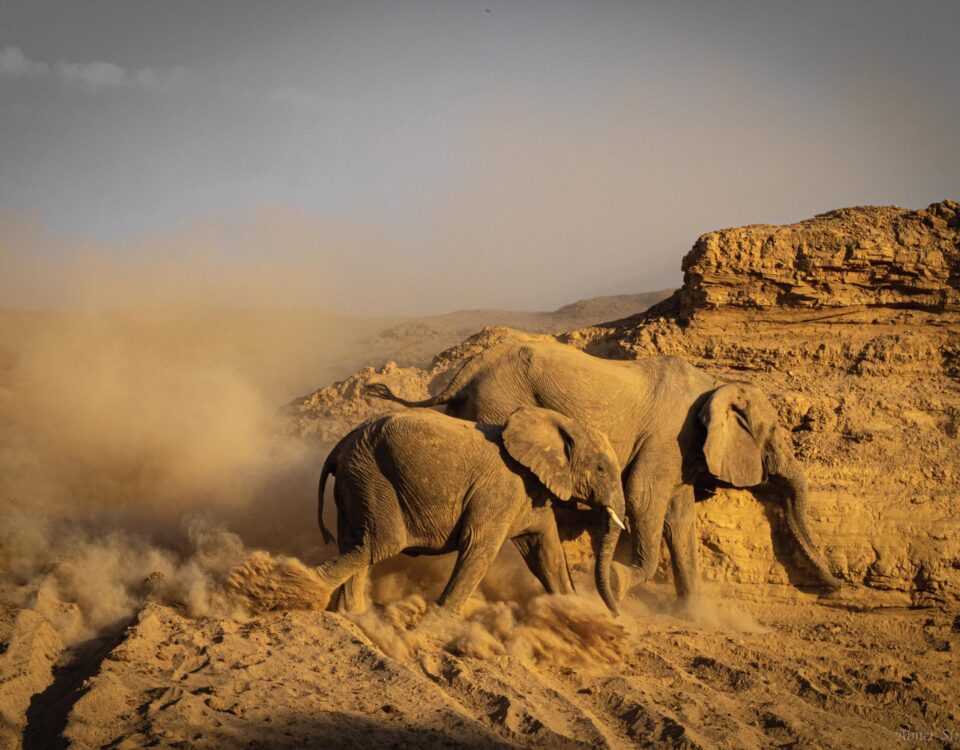
Rose quartz
May 29, 2017
Paradise has a new name
June 2, 2017Travel News Namibia sets off with Wilderness Safaris on an epic adventure from Namibia to our neighbour, Botswana.
Text and photographs Elzanne Erasmus

T he morning light slowly breaks over the horizon as we set off into the lush African bush. It’s early, but the wilderness we find ourselves in is awake around us. Not having had my third cup of coffee for the morning yet, I give a bleary-eyed yawn as my brain slowly wakes in time to the sidling sun. Another day in beautiful Africa, but for once I do not find myself surrounded by the familiar arid landscapes of my homeland. There are no dunes or rocky mountainscapes in sight. The tell-tale yellow hues of grasslands after a substantial rainy season find themselves conspicuously replaced by shades of bright green. As our game-viewer meanders through lush woodland, over ruggedly built wooden bridges traversing watercourses and floodplains, I marvel at the abundance of flora and fauna. Rather unfamiliar antelope amble through the wet green grasslands to our left. A herd of elephants is on the way to a riverbank in the distance. There are birds everywhere. Ones I am familiar with only because I have been fortunate enough to venture into the Zambezi Region of my country’s northeast once or twice before. Tall trees of the leadwood and teak variety loom overhead, and everything is just so… green. No Toto, I’m definitely not in Namibia anymore…



VENI. VIDI. AMAVI. (WE CAME. WE SAW. WE LOVED.)
Adjacent to Moremi National Park is the Chitabe concession with Chitabe Lediba, the first stop on my Botswana adventure. Our journey from the airstrip to the lodge leads us through a forest of dead acacia trees. The eerie effect created by the dark naked limbs of these ancient trees is wonderfully dramatic. A small herd of elephants make their way through the bare forest. But everything, including the trees, is soon teeming with life again and hidden within the wilderness surrounded by water lies Chitabe Lediba. The dirt soccer field is flooded and currently a lioness is making more use of it than the staff. Overlooking a floodplain, the beautiful lodge is stretched out along the edge of an island. We admire a family of hyena at their den just before sunset that evening. Five different generations in one view. The younger ones learning their curious ways from their older cousins. Our game drive the next day is highlighted by a pride of lions. We follow them as they stalk a herd of impala through the thick brush. The sheer density of animals in this wilderness wonderland astounds me. While we wait for the lions to make their move we watch a herd of elephant graze on the green foliage. Zebras look on, ears perked and alert. The impala are skittish, they know something is afoot. The slightest provocation from an overeager feline sends the entire herd into a panic and they flee the scene. Maybe next time girls… Gin and tonics next to the river are the perfect end to a day unwinding with the setting sun.
Tea-time on our last Chitabe day is marked by a quick, yet highly informative geography lesson. Lodge manager Thompson tells us about the wonders of the delta. How it was formed, the ever-changing landscape and the movement of animals. I’m amazed at the intricacies involved in the construction and constant renovation of the southernmost point of the Rift Valley. He describes how the islands in the delta are formed: changing water levels, a build-up of debris, shifting Kalahari sands and even termite mounds culminate in an ever-changing system of river courses and islands forming one of the greatest and most visually dramatic wetland areas in the world.
GOOD PEOPLE BRING OUT THE GOOD IN PEOPLE
Botswana, home to the largest population of elephants in Africa, is also home to an abundance of smiling faces. The Setswana speaking Batswana people and the conservancies they call home are direct beneficiaries of joint-venture lodges such as those owned and managed by Wilderness Safaris. Operating according to a similar system as their Namibian counterpart, Wilderness hires local. These locals know their native land and thus are the obvious choice to host and guide guests from across the world. The delta is not only teeming with incredible animals and bird life, but also generates incredible voices and stories of inspiring individuals working their way up into management positions, often after starting out as kitchen staff. The guides I was lucky enough to not only meet but befriend on this excursion into the wilderness ticked-off everything on my “how to be an amazing guide” checklist. It’s all about the personality. You have to be one strong, intelligent, out-going, assertive, patient, benevolent, organised, efficient, patient, funny and kind person with an excellent memory and a great sense of humour to be a great guide. Did I mention patient? Well, our guides succeeded in spades! There are few things that I love more than listening to guides’ stories. They have a wealth of tales to tell and amazing bush life experiences to share, so listen with bated breath and hang on their every word!
BREATHING DREAMS LIKE AIR
Taking to the sky in a Cessna with a bush pilot at the helm, we set off from Chitabe to our next destination, King’s Pool. The bird’s eye view over the delta is something every Africa-lover or travel enthusiast should put on their bucket list. Having learned all about the different island formations from Thompson the day before, I kept a keen eye on the amazing sights below. I was even treated to the view of a massive elephant bull grazing along the marshlands. On the southern bank of the Linyanti River lies a breath-taking camp. The welcoming staff and utter luxury sets King’s Pool far above the benchmark of safari luxury. Treated like royalty, fed like a queen and spoiled rotten with luxuries such as a full body massage in my room overlooking the river while a hippo chortled downstream, it was quite a tear-jerker moment when it became time to leave… Our stay at King’s Pool was filled with all the best Botswana has to offer: lush green and wet landscapes, an abundance of animals and birds…. so many birds. On safari expeditions such as these, one often spends up to eight hours a day driving around the bush. Not to worry though, the phrases time flies when you’re having fun and time spent having fun is never wasted were coined for moments such as these.
EARNING YOUR SPOTS
Did you know that hyenas are not born with their spots? They grow into them! When born, hyena cubs have a black pelt, which grows into a lighter fur with dark spots.
TOP TIP FROM A GUIDE:
TRACKING ANIMAL BEHAVIOUR:
At a kill, the Hooded Vulture will always sit closest to the site. They need to get to the kill early because they are the smallest and weakest of the vultures. A zebra kill can lure many different species to a site: lion, leopard, hyena, jackal, vultures, Tawny Eagle etc.







COLLECT BEAUTIFUL MOMENTS
My second-last day with Wilderness in Botswana was spent counting. Not fingers or toes or sheep, but rather feathered friends. The Big Birding Day officially started at 05:30 in the morning, and we had until 23:00 that evening to identify and record as many different bird species as possible. So we set off on a new kind of adventure. Why care about the giraffe browsing in tall trees to our right when there was an LBJ* in the tree ahead of us that needed identification! Non-birders may not understand the enthusiasm of those who keep their binocs pinned to their eye sockets when something winged passes. It becomes a slight (sarcasm!) obsession when the birding bug bites. And on a day like this, when all the Wilderness Safaris camps in Botswana take part in a competition to see which team can identify the greatest variety of birds, the bug bites hard and leaves a mark. Necks craned, binocs at the ready, we scoured the floodplains and trails of the wilderness area surrounding King’s Pool camp and counted and counted and counted. Our tally by the end of the day was 67 different bird species. The winning team got 142. We are firmly convinced that they did not have as rigorous a quality controller as we had and some LBJs probably got slipped into their list as a Familiar Chat… or four.
FIND ME WHERE THE WILD THINGS ARE
So there I sat, on a lounge seat overlooking a mighty African river. Beyond lay a beautiful sight. The view from my perch extended over King’s Pool, and beyond to where home is. Namibia and Botswana are not such distant cousins. They share many wonders: The Kalahari Sands, the life-giving Okavango. They share the spirit of Africa, too, and a deep love for nature and all it encompasses. This wonderful corner of southern Africa is for the nature-lovers, the adventurers, the passionate seekers of beauty and grace.
DID YOU KNOW?
The Okavango Delta was proclaimed a UNESCO Natural World Heritage site in 2014, making it the 1000th site.
NOTE:
If you are self-driving with a rental car, make sure to have all the required cross-border paperwork from your rental company. A fee is payable at customs on Botswana’s side. They accept Visa and MasterCard so cash on hand is not crucial.
BOOK WITH WILDERNESS
To book your Botswana adventure with Wilderness Safaris, visit: www.wilderness-safaris.com, or send an e-mail to enquiries@wilderness-safaris.com.
HOW TO GET THERE:
So you want to connect your next trip to Namibia with our beautiful and enigmatic neighbour Botswana… Well, we think that is a fabulous idea!
HERE’S HOW TO DO IT:
From Namibia’s capital, self-drivers can take the B2 route leading east to Gobabis and cross the border into Botswana at Buitepos. If your destination is the Okavango Delta, as mine was, Maun is an approximate 8-hour drive from Windhoek. Choose from any number of accommodation options in the Ghanzi area if you don’t want to make the trip in one go. Look out for interesting stopovers along the way, such as Lake Ngami – a birders’ wonderland!
If you’d rather fly, there are a number of options. If your trip from distant lands takes you via Johannesburg, it may be easier to catch a connecting flight to Maun before your visit to Namibia. But if you are visiting Namibia first you can either fly from Windhoek to Johannesburg and then to Maun, or from Windhoek to Botswana’s capital Gaborone, where you can catch a connecting flight to the delta’s basecamp.



This article was first published in the Travel News Namibia Winter 2017 issue.


